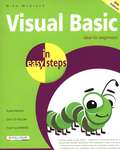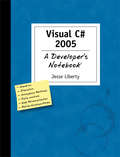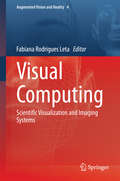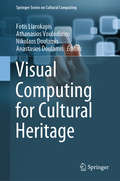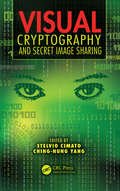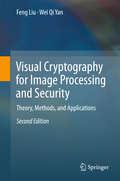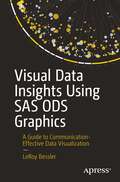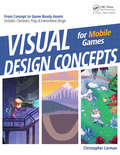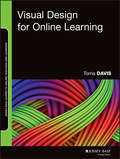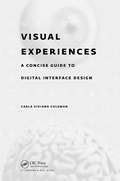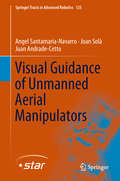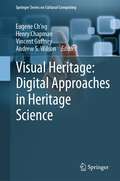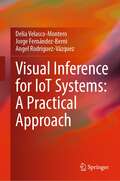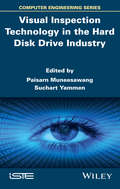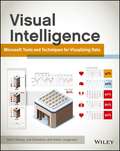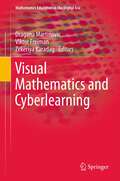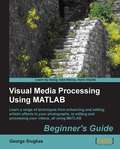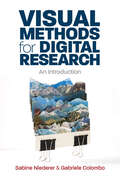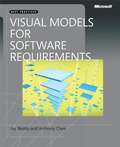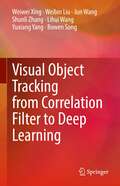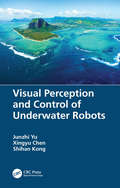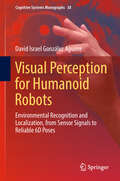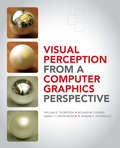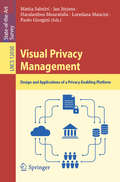- Table View
- List View
Visual Basic in Easy Steps: Updated for Visual Basic 2019
by Mike McGrathVisual Basic in easy steps, 6th edition gives you code examples, screenshots, and step-by-step instructions that illustrate each aspect of Visual Basic so you'll be creating your own interactive applications in no time!. <p><p> You need have no previous knowledge of any programming language so it's ideal if you're a newcomer to Windows programming. Each chapter builds your knowledge of Visual Basic. By the end of this book you will have gained a sound understanding of Visual Basic programming and be able to create your own interactive applications. <p><p> Visual Basic in easy steps, 6th edition has an easy-to-follow style that will appeal to anyone who wants to begin Windows programming. It will appeal to programmers who want to quickly learn the latest Visual Basic techniques, and to the student who is studying computing at school or college, and to those seeking a career in Information Technology who needs a thorough understanding of Visual Basic programming.
Visual C# 2005: A Developer's Notebook
by Jesse LibertyIn the three years since Microsoft made C# available, there have been lots of tweaks to the language. That's because C# is not only essential for making .NET work, it's a big way for Microsoft to attract millions of Java, C and C++ developers to the platform. And C# has definitely made some inroads. Because of its popularity among developers, the language received standardization from ECMA International, making it possible to port C# applications to other platforms. To bolster its appeal, C# 2.0 has undergone some key changes as part of Visual Studio 2005 that will make development with .NET quicker and easier. That's precisely what Visual C# 2005: A Developer's Notebook allows you to do. There are some great new features in C# and this unique "all lab, no lecture" guide covers them all with 50 hands-on projects. Each project explores a new feature, with emphasis on changes that increase productivity, simplify programming tasks, and add functionality to applications. C#'s component-based design combines the productivity of Microsoft's popular Visual Basic with the raw power of C++ for web-based applications. Many reviewers note a similarity between C# and Java--in fact, a new feature that took the Java development team five years to incorporate into Java is now available in C# 2.0. Called "generics", this feature enables developers to reuse and customize their existing code, so they can dramatically cut down the time it takes to develop new applications. Visual C# 2005: A Developer's Notebook is full of no-nonsense code without the usual page-filling commentary. You'll find suggestions for further experimentation, links to on-line documentation, plus practical notes and warnings. The book also tells developers how to acquire, install and configure Visual Studio 2005. Are you a coder to the core? Learn what C# 2.0 can do for you now.
Visual Computing
by Fabiana Rodrigues LetaThis volume aims to stimulate discussions on research involving the use of data and digital images as an understanding approach for analysis and visualization of phenomena and experiments. The emphasis is put not only on graphically representing data as a way of increasing its visual analysis, but also on the imaging systems which contribute greatly to the comprehension of real cases. Scientific Visualization and Imaging Systems encompass multidisciplinary areas, with applications in many knowledge fields such as Engineering, Medicine, Material Science, Physics, Geology, Geographic Information Systems, among others. This book is a selection of 13 revised and extended research papers presented in the International Conference on Advanced Computational Engineering and Experimenting -ACE-X conferences 2010 (Paris), 2011 (Algarve), 2012 (Istanbul) and 2013 (Madrid). The examples were particularly chosen from materials research, medical applications, general concepts applied in simulations and image analysis and other interesting related problems.
Visual Computing for Cultural Heritage (Springer Series on Cultural Computing)
by Anastasios Doulamis Fotis Liarokapis Athanasios Voulodimos Nikolaos DoulamisThis book provides insights into the state of the art of digital cultural heritage using computer graphics, image processing, computer vision, visualization and reconstruction, virtual and augmented reality and serious games. It aims at covering the emergent approaches for digitization and preservation of Cultural Heritage, both in its tangible and intangible facets. Advancements in Digital Cultural Heritage research have been abundant in recent years covering a wide assortment of topics, ranging from visual data acquisition, pre-processing, classification, analysis and synthesis, 3D modelling and reconstruction, semantics and symbolic representation, metadata description, repository and archiving, to new forms of interactive and personalized presentation, visualization and immersive experience provision via advanced computer graphics, interactive virtual and augmented environments, serious games and digital storytelling. Different aspects pertaining to visual computing with regard to tangible (books, images, paintings, manuscripts, uniforms, maps, artefacts, archaeological sites, monuments) and intangible (e.g. dance and performing arts, folklore, theatrical performances) cultural heritage preservation, documentation, protection and promotion are covered, including rendering and procedural modelling of cultural heritage assets, keyword spotting in old documents, drone mapping and airborne photogrammetry, underwater recording and reconstruction, gamification, visitor engagement, animated storytelling, analysis of choreographic patterns, and many more. The book brings together and targets researchers from the domains of computing, engineering, archaeology and the arts, and aims at underscoring the potential for cross-fertilization and collaboration among these communities.
Visual Cryptography and Secret Image Sharing
by Ching-Nung Yang Stelvio CimatoWith rapid progress in Internet and digital imaging technology, there are more and more ways to easily create, publish, and distribute images. Considered the first book to focus on the relationship between digital imaging and privacy protection, Visual Cryptography and Secret Image Sharing is a complete introduction to novel security methods and sharing-control mechanisms used to protect against unauthorized data access and secure dissemination of sensitive information. Image data protection and image-based authentication techniques offer efficient solutions for controlling how private data and images are made available only to select people. Essential to the design of systems used to manage images that contain sensitive data—such as medical records, financial transactions, and electronic voting systems—the methods presented in this book are useful to counter traditional encryption techniques, which do not scale well and are less efficient when applied directly to image files. An exploration of the most prominent topics in digital imaging security, this book discusses: Potential for sharing multiple secrets, Visual cryptography schemes—based either on the probabilistic reconstruction of the secret image, or on different logical operations for combining shared images, Inclusion of pictures in the distributed shares, Contrast enhancement techniques, Color-image visual cryptography, Cheating prevention, Alignment problems for image shares, Steganography and authentication In the continually evolving world of secure image sharing, a growing number of people are becoming involved as new applications and business models are being developed all the time. This contributed volume gives academicians, researchers, and professionals the insight of well-known experts on key concepts, issues, trends, and technologies in this emerging field.
Visual Cryptography for Image Processing and Security
by Feng Liu Wei Qi YanThis unique book describes the fundamental concepts, theories and practice of visual cryptography. The design, construction, analysis, and application of visual cryptography schemes (VCSs) are discussed in detail. Original, cutting-edge research is presented on probabilistic, size invariant, threshold, concolorous, and cheating immune VCS. Features: provides a thorough introduction to the field; examines various common problems in visual cryptography, including the alignment, flipping, cheating, distortion, and thin line problems; reviews a range of VCSs, including XOR-based visual cryptography and security enriched VCS; describes different methods for presenting color content using visual cryptographic techniques; covers such applications of visual cryptography as watermarking, resolution variant VCS, and multiple resolution VCS. This logically-structured and comprehensive work will serve as a helpful reference for all researchers and students interested in document authentication and cryptography.
Visual Data Insights Using SAS ODS Graphics: A Guide to Communication-Effective Data Visualization
by LeRoy BesslerSAS ODS graphics users will learn in this book how to visually understand and communicate the significance of data to deliver images for quick and easy insight, with precise numbers. Many charts or plots require the viewer to run the eye from a bar end or plot point to some point on an axis, and then to interpolate between tick marks to estimate the value. Some design choices can lead to wrong conclusions or mistaken impressions. Graphic software relies on defaults to deliver something if you make a minimal effort, but that something is not likely to be exactly what you want. Visual Data Insights Using SAS ODS Graphics provides examples using experience-based design principles. It presents examples of bar charts, pie charts, and trend lines or time series plots, the graph types commonly used in business, other organizations, and the media for visual insight into data. Newer graphs are also included: dot plots, needle plots, waterfall charts, butterfly charts, heat maps, bubble plots, step plots, high-low plots, and donut charts. In addition, there are basic tools of statistics: scatter plots, box plots, histograms, fit and confidence plots, and distributions. Author LeRoy Bessler introduces unique creations, including sparsely annotated time series, maximally informative bar charts, better box plots, histograms based on interesting atypical rationales, and much more. The examples use SAS sample data sets as input. Any SAS user can experiment with the code presented to see what else is possible, or adapt it to repurpose the design and apply it with a customized version of that code.What You’ll Learn Create graphs that are easily and quickly interpreted, and without ambiguitySupply precise data values that are correct on the graph and correctly associated with the graphic visual elementsTake advantage of widely applicable (but not necessarily available elsewhere) design examplesAvoid bad practices that are encouraged by poor examples elsewhereGet past sub-optimal designs and results that are built into software defaultsTake advantage of less familiar capabilities available in the software Who This Book Is For SAS software users who want to understand their data and/or visually deliver their results
Visual Design Concepts For Mobile Games
by Chirstopher P CarmanThis book is geared towards both students as well as professionals who are looking to enter the mobile (tablet/smartphone) and PC (personal computer) industry as concept artists (for both 2D and 3D production pipelines) or 2D production artists (game-ready assets). This book is not specifically focused on game design or game development and is also not a 3D modeling or animation guide. However, certain aspects of game design, game development, and 3D modeling and animation will impact the visual development and art creation process. So, at points throughout we will explore topics such as game engine performance and game mechanics, though at a very high-level, bird's-eye, vantage point and only as they pertain to the visual development of the various assignments throughout this book. Through the completion of the exercises and assignments contained within Visual Development for Web & Mobile Games readers will be guided through the visual development process and execution of a variety of concepts and assets (final game art). This includes categories such as characters, props, and backgrounds, within an isometric design template. The categories themselves will relate more to their function within a very simple game design template than their completed visual representation (e.g., the "big build-able" category could be anything from a town square to a fire breathing dragon as long as it fits within the bare bones parameters of the asset types functionality). The concept, theme, and style of these assets, as well as the world they inhabit, will be completely up to the individual artist. Key Features Weaves knowledge of classic visual development principles and web/mobile game art production practices. Assignments and exercises at the end of every chapter allow the reader to create a game art project from start to finish. Examines both 2D/3D game art pipelines. Includes a companion website with project files, asset downloads & author created video tutorials.
Visual Design for Online Learning
by Torria DavisUpdate the visual design of your course in pedagogically sound ways Visual Design for Online Learning spotlights the role that visual elements play in the online learning environment. Written for both new and experienced instructors, the book guides you in adding pedagogically relevant visual design elements that contribute to effective learning practices. The text builds upon three conceptual frameworks: active learning, multiple intelligences, and universal design for learning. This resource explores critical issues such as copyright, technology tools, and accessibility and includes examples from top Blackboard practitioners which are applicable to any LMS. Ultimately, the author guides you in developing effective visual elements that will support your teaching goals while reinforcing the learning materials you share with your students. There has been a steady increase of over 10% in online enrollment for higher education institutions since 2002, yet the visual look of online courses has not changed significantly in the last ten years. Adapting to the needs of students within online classes is critical to guiding your students toward success--and the right visual elements can play an integral role in your students' ability to learn and retain the information they need to thrive in their chosen programs. In fact, visual elements have been shown to increase student participation, engagement, and success in an online course. Leverage the best practices employed by exemplary Blackboard practitioners Explore three foundational conceptual frameworks: active learning, multiple intelligences, and universal design for learning Increase student retention and success Visual Design for Online Learning is an essential reference for all online educators--both new and experienced.
Visual Experiences: A Concise Guide to Digital Interface Design
by Carla Viviana ColemanVisual Experiences: A Concise Guide to Digital Interface Design provides step-by-step examples to enable readers to create an interface, guiding them from sketching an idea to creating an interactive prototype. This creation of a visual experience is achieved in three steps: thought, design, and interaction. This book focuses on the visual experience of digital interface design from the initial idea to end-user prototype. Key Features Shows how to design visual digital interface experiences: a concise guide to creating successful prototypes without programming. Teaches the whole process of how to sketch, design, and create interactions. Unlike other books, this book does not just give a list of terminologies, but workable examples and methods. Includes a wide range of basic to advanced exercises geared towards professionals and students alike. Includes many illustrations throughout the book, guiding the reader through the process.
Visual Guidance of Unmanned Aerial Manipulators (Springer Tracts in Advanced Robotics #125)
by Juan Andrade-Cetto Angel Santamaria-Navarro Joan SolàThis monograph covers theoretical and practical aspects of the problem of autonomous guiding of unmanned aerial manipulators using visual information. For the estimation of the vehicle state (position, orientation, velocity, and acceleration), the authors propose a method that relies exclusively on the use of low-cost and highrate sensors together with low-complexity algorithms. This is particularly interesting for applications in which on board computation with low computation power is needed. Another relevant topic covered in this monograph is visual servoing. The authors present an uncalibrated visual servo scheme, capable of estimating at run time, the camera focal length from the observation of a tracked target. The monograph also covers several control techniques, which achieve a number of tasks, such as robot and arm positioning, improve stability and enhance robot arm motions. All methods discussed in this monograph are demonstrated in simulation and through real robot experimentation. The text is appropriate for readers interested in state estimation and control of aerial manipulators, and is a reference book for people who work in mobile robotics research in general.
Visual Heritage: Digital Approaches in Heritage Science (Springer Series on Cultural Computing)
by Eugene Ch'Ng Vincent Gaffney Henry Chapman Andrew S. WilsonHow we understand our shared and individual heritage, interpret and disseminate that knowledge is increasingly central to contemporary society. The emerging context for such development is the field of heritage science. Inherently interdisciplinary, and involving both the Arts and Humanities, engineering, conservation and the digital sciences, the development of heritage science is a driver for change; socially, economically and technically. This book has gathered contributions from leading researchers from across the world and provides a series of themed contributions demonstrating the theoretical, ethical, methodological and technical methods which lie at the heart of heritage science. Archaeology, conservation, museology, the arts, forensic sciences, and heritage management are represented through collaborative research with specialists in applied technologies including object and terrestrial laser scanning, multi-spectral imaging, visualisation, GIS and 3D-printing. Together, the chapters present important case studies to demonstrate the recent advances and best practise within the discipline, highlighting the value of digital transformation across the heritage community that includes objects, monuments, sites and landscapes spanning two million years of natural and cultural history from all over the world. Visual Heritage: Digital Approaches in Heritage Science is aimed at a broad academic and practice-led readership, which extends across many disciplines and will be of considerable value to scholars, practitioners, and students working within heritage and computer science at all levels. The content, which applies heritage science across two million years of cultural history will be appreciated by a general audience, as well as those wishing simply to explore the vast range of potential technical applications across all the disciplines represented in the book.
Visual Inference for IoT Systems: A Practical Approach
by Angel Rodríguez-Vázquez Jorge Fernández-Berni Delia Velasco-MonteroThis book presents a systematic approach to the implementation of Internet of Things (IoT) devices achieving visual inference through deep neural networks. Practical aspects are covered, with a focus on providing guidelines to optimally select hardware and software components as well as network architectures according to prescribed application requirements. The monograph includes a remarkable set of experimental results and functional procedures supporting the theoretical concepts and methodologies introduced. A case study on animal recognition based on smart camera traps is also presented and thoroughly analyzed. In this case study, different system alternatives are explored and a particular realization is completely developed. Illustrations, numerous plots from simulations and experiments, and supporting information in the form of charts and tables make Visual Inference and IoT Systems: A Practical Approach a clear and detailed guide to the topic. It will be of interest to researchers, industrial practitioners, and graduate students in the fields of computer vision and IoT.
Visual Inspection Technology in the Hard Disc Drive Industry
by Paisarn Muneesawang Suchart YammenA presentation of the use of computer vision systems to control manufacturing processes and product quality in the hard disk drive industry. Visual Inspection Technology in the Hard Disk Drive Industry is an application-oriented book borne out of collaborative research with the world's leading hard disk drive companies. It covers the latest developments and important topics in computer vision technology in hard disk drive manufacturing, as well as offering a glimpse of future technologies.
Visual Intelligence
by Mark Stacey Adam Jorgensen Joe SalvatoreGo beyond design concepts and learn to build state-of-the-art visualizationsThe visualization experts at Microsoft's Pragmatic Works have created a full-color, step-by-step guide to building specific types of visualizations. The book thoroughly covers the Microsoft toolset for data analysis and visualization, including Excel, and explores best practices for choosing a data visualization design, selecting tools from the Microsoft stack, and building a dynamic data visualization from start to finish. You'll examine different types of visualizations, their strengths and weaknesses, and when to use each one. Data visualization tools unlock the stories within the data, enabling you to present it in a way that is useful for making business decisionsThis full-color guide introduces data visualization design concepts, then explains the various Microsoft tools used to store and display dataFeatures a detailed discussion of various classes of visualizations, their uses, and the appropriate tools for each Includes practical implementations of various visualizations and best practices for using themCovers out-of-the-box Microsoft tools, custom-developed illustrations and implementations, and code examplesVisual Intelligence: Microsoft Tools and Techniques for Visualizing Data arms you with best practices and the knowledge to choose and build dynamic data visualizations.
Visual Mathematics and Cyberlearning
by Viktor Freiman Dragana Martinovic Zekeriya KaradagThis first book in the series will describe the Net Generation as visual learners who thrive when surrounded with new technologies and whose needs can be met with the technological innovations. These new learners seek novel ways of studying, such as collaborating with peers, multitasking, as well as use of multimedia, the Internet, and other Information and Communication Technologies. Here we present mathematics as a contemporary subject that is engaging, exciting and enlightening in new ways. For example, in the distributed environment of cyber space, mathematics learners play games, watch presentations on YouTube, create Java applets of mathematics simulations and exchange thoughts over the Instant Messaging tool. How should mathematics education resonate with these learners and technological novelties that excite them?
Visual Media Processing Using Matlab Beginner's Guide
by George SiogkasWritten in a friendly, Beginner's Guide format, showing the user how to use the digital media aspects of Matlab (image, video, sound) in a practical, tutorial-based style.This is great for novice programmers in any language who would like to use Matlab as a tool for their image and video processing needs, and also comes in handy for photographers or video editors with even less programming experience wanting to find an all-in-one tool for their tasks.
Visual Methods for Digital Research: An Introduction
by Sabine Niederer Gabriele ColomboOver the last decade, images have become a key feature of digital culture; at the same time, they have made a mark on a wide range of research practices.Visual Methods for Digital Research is the first textbook to bring the fields of visual methods and digital research together. Presenting visual methods for digital and participatory research, the book covers both the application of existing digital methods for image research and new visual methodologies developed specifically for digital research. It encompasses various approaches to studying digital images, including the distant reading of image collections, the close reading of visual vernaculars of social media platforms, and participatory research with visual materials. Offering a theoretical framework illustrated with hands-on techniques, Sabine Niederer and Gabriele Colombo provide compelling examples for studying online images through visual and digital means, and discuss critical data practices such as data feminism and digital methods for social and cultural research.This textbook is an accessible and invaluable guide for students and researchers of digital humanities, social sciences, information and communication design, critical data visualization and digital visual culture.
Visual Models for Software Requirements
by Anthony Chen Joy BeattyApply best practices for capturing, analyzing, and implementing software requirements through visual models--and deliver better results for your business. The authors--experts in eliciting and visualizing requirements--walk you through a simple but comprehensive language of visual models that has been used on hundreds of real-world, large-scale projects. Build your fluency with core concepts--and gain essential, scenario-based context and implementation advice--as you progress through each chapter. Transcend the limitations of text-based requirements data using visual models that more rigorously identify, capture, and validate requirements Get real-world guidance on best ways to use visual models--how and when, and ways to combine them for best project outcomes Practice the book's concepts as you work through chapters Change your focus from writing a good requirement to ensuring a complete system
Visual Object Tracking from Correlation Filter to Deep Learning
by Lihui Wang Jun Wang Weibin Liu Weiwei Xing Shunli Zhang Yuxiang Yang Bowen SongThe book focuses on visual object tracking systems and approaches based on correlation filter and deep learning. Both foundations and implementations have been addressed. The algorithm, system design and performance evaluation have been explored for three kinds of tracking methods including correlation filter based methods, correlation filter with deep feature based methods, and deep learning based methods. Firstly, context aware and multi-scale strategy are presented in correlation filter based trackers; then, long-short term correlation filter, context aware correlation filter and auxiliary relocation in SiamFC framework are proposed for combining correlation filter and deep learning in visual object tracking; finally, improvements in deep learning based trackers including Siamese network, GAN and reinforcement learning are designed. The goal of this book is to bring, in a timely fashion, the latest advances and developments in visual object tracking, especially correlation filter and deep learning based methods, which is particularly suited for readers who are interested in the research and technology innovation in visual object tracking and related fields.
Visual Pattern Discovery and Recognition
by Junsong Yuan Hongxing Wang Chaoqun WengThis book presents a systematic study of visual pattern discovery, from unsupervised to semi-supervised manner approaches, and from dealing with a single feature to multiple types of features. Furthermore, it discusses the potential applications of discovering visual patterns for visual data analytics, including visual search, object and scene recognition. It is intended as a reference book for advanced undergraduates or postgraduate students who are interested in visual data analytics, enabling them to quickly access the research world and acquire a systematic methodology rather than a few isolated techniques to analyze visual data with large variations. It is also inspiring for researchers working in computer vision and pattern recognition fields. Basic knowledge of linear algebra, computer vision and pattern recognition would be helpful to readers.
Visual Perception and Control of Underwater Robots
by Junzhi Yu Xingyu Chen Shihan KongVisual Perception and Control of Underwater Robots covers theories and applications from aquatic visual perception and underwater robotics. Within the framework of visual perception for underwater operations, image restoration, binocular measurement, and object detection are addressed. More specifically, the book includes adversarial critic learning for visual restoration, NSGA-II-based calibration for binocular measurement, prior knowledge refinement for object detection, analysis of temporal detection performance, as well as the effect of the aquatic data domain on object detection. With the aid of visual perception technologies, two up-to-date underwater robot systems are demonstrated. The first system focuses on underwater robotic operation for the task of object collection in the sea. The second is an untethered biomimetic robotic fish with a camera stabilizer, its control methods based on visual tracking. The authors provide a self-contained and comprehensive guide to understand underwater visual perception and control. Bridging the gap between theory and practice in underwater vision, the book features implementable algorithms, numerical examples, and tests, where codes are publicly available. Additionally, the mainstream technologies covered in the book include deep learning, adversarial learning, evolutionary computation, robust control, and underwater bionics. Researchers, senior undergraduate and graduate students, and engineers dealing with underwater visual perception and control will benefit from this work.
Visual Perception for Humanoid Robots: Environmental Recognition and Localization, from Sensor Signals to Reliable 6D Poses (Cognitive Systems Monographs #38)
by David Israel González AguirreThis book provides an overview of model-based environmental visual perception for humanoid robots. The visual perception of a humanoid robot creates a bidirectional bridge connecting sensor signals with internal representations of environmental objects. The objective of such perception systems is to answer two fundamental questions: What & where is it? To answer these questions using a sensor-to-representation bridge, coordinated processes are conducted to extract and exploit cues matching robot’s mental representations to physical entities. These include sensor & actuator modeling, calibration, filtering, and feature extraction for state estimation. This book discusses the following topics in depth: • Active Sensing: Robust probabilistic methods for optimal, high dynamic range image acquisition are suitable for use with inexpensive cameras. This enables ideal sensing in arbitrary environmental conditions encountered in human-centric spaces. The book quantitatively shows the importance of equipping robots with dependable visual sensing. • Feature Extraction & Recognition: Parameter-free, edge extraction methods based on structural graphs enable the representation of geometric primitives effectively and efficiently. This is done by eccentricity segmentation providing excellent recognition even on noisy & low-resolution images. Stereoscopic vision, Euclidean metric and graph-shape descriptors are shown to be powerful mechanisms for difficult recognition tasks. • Global Self-Localization & Depth Uncertainty Learning: Simultaneous feature matching for global localization and 6D self-pose estimation are addressed by a novel geometric and probabilistic concept using intersection of Gaussian spheres. The path from intuition to the closed-form optimal solution determining the robot location is described, including a supervised learning method for uncertainty depth modeling based on extensive ground-truth training data from a motion capture system.The methods and experiments are presented in self-contained chapters with comparisons and the state of the art. The algorithms were implemented and empirically evaluated on two humanoid robots: ARMAR III-A & B. The excellent robustness, performance and derived results received an award at the IEEE conference on humanoid robots and the contributions have been utilized for numerous visual manipulation tasks with demonstration at distinguished venues such as ICRA, CeBIT, IAS, and Automatica.
Visual Perception from a Computer Graphics Perspective
by William Thompson Sarah Creem-Regehr Roland Fleming Jeanine Kelly StefanucciThis book provides an introduction to human visual perception suitable for readers studying or working in the fields of computer graphics and visualization, cognitive science, and visual neuroscience. It focuses on how computer graphics images are generated, rather than solely on the organization of the visual system itself; therefore, the text pro
Visual Privacy Management: Design and Applications of a Privacy-Enabling Platform (Lecture Notes in Computer Science #12030)
by Haralambos Mouratidis Paolo Giorgini Mattia Salnitri Jan Jürgens Loredana ManciniPrivacy is a burden for most organizations, the more complex and wider an organization is, the harder to manage and enforce privacy is.GDPR and other regulations on privacy impose strict constraints that must be coherently enforced, considering also privacy needs of organization and their users. Furthermore, organizations should allow their users to express their privacy needs easily, even when the process that manages users' data is complex and involves multiple organizations.Many research work consider the problem using simplistic examples, with solutions proposed that never actually touch pragmatic problems of real, large organizations, with thousands of users and terabytes of personal and sensitive data.This book faces the privacy management problem targeting actual large organizations, such as public administrations, including stakeholders in the process of definition of the solution and evaluating the results with its actual integration in four large organizations. The contribution of this book is twofold: a privacy platform that can be customized and used to manage privacy in large organizations; and the process for the design of such a platform, from a state-of-the-art survey on privacy regulations, through the definition of its requirements, its design and its architecture, until the evaluation of the platform.
